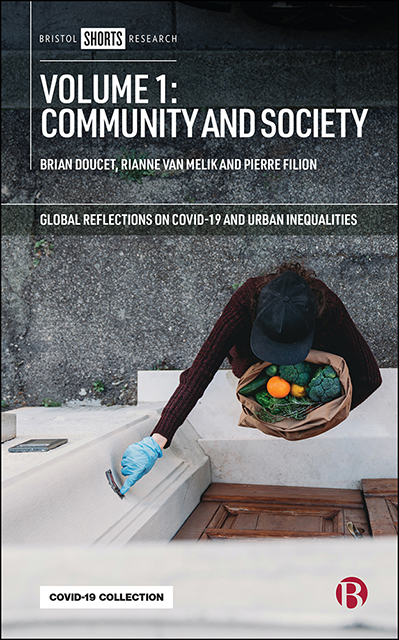Book contents
- Frontmatter
- Contents
- List of Figures and Tables
- Notes on Contributors
- Acknowledgments
- Preface to All Four Volumes of Global Reflections on COVID-19 and Urban Inequalities
- One Introduction
- Part I Working Practices
- Part II Life During Lockdown
- Part III Migration, Migrants, and Refugees
- Part IV Age, Race, Gender, and Ability
- Index
One - Introduction
Published online by Cambridge University Press: 13 April 2023
- Frontmatter
- Contents
- List of Figures and Tables
- Notes on Contributors
- Acknowledgments
- Preface to All Four Volumes of Global Reflections on COVID-19 and Urban Inequalities
- One Introduction
- Part I Working Practices
- Part II Life During Lockdown
- Part III Migration, Migrants, and Refugees
- Part IV Age, Race, Gender, and Ability
- Index
Summary
Pandemic imagery and urban inequalities
This series of four books explores the relationship between the COVID-19 pandemic and a variety of inter-related economic, social, spatial, and racial inequalities that have come to characterize cities around the world in the twenty-first century. Each volume explores a different, yet connected topic within urban studies, geography, and planning. This volume examines divisions within urban communities and societies and discusses to what extent the pandemic has created new inequalities, or amplified existing ones?
During the first wave of lockdowns that quickly spread around the world, images of empty streets, stations, squares, highways, and markets presented a dramatic view of cities that constituted an immediate break from the pre-COVID-19 era. Often juxtaposed beside images of the same spaces in far busier times, these photographs were almost entirely devoid of people who were otherwise hunkered down in their houses. They gave the impression that everything had changed and that life as we knew it had come to a standstill. They also gave hope of a return to normality, as once-busy places waited patiently for life to return back to the way it was (see The Guardian, 2020).
These images were, however, an overly simplistic, onedimensional representation of cities under lockdown. The reality, in most areas of urban life, was far more complex. Rather than everything changing, the first year of the COVID-19 pandemic has also demonstrated that much has remained the same: the inequalities that characterized cities before the pandemic have been central to understanding both the unequal impacts of the virus on urban communities and the different ways in which the city has been experienced during the pandemic. These inequalities have been amplified, and the power relations that govern cities and urban space have barely changed: those who had little influence in planning and policymaking before the pandemic continue to be absent from them. While much of the world's attention is now focused on inequalities, individuals and communities who have long suffered injustices, and discrimination have seen little justice during the pandemic. This is important to remember when viewing images of cities during lockdown. While the dominant visuals have been of empty spaces, many people still leave their homes each day to perform essential work that cannot be done at home.
- Type
- Chapter
- Information
- Volume 1: Community and Society , pp. 1 - 18Publisher: Bristol University PressPrint publication year: 2021



